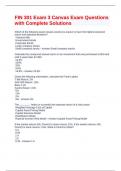Exam (elaborations)
FIN 301 Exam 3 Canvas Exam Questions with Complete Solutions
- Course
- Institution
Which of the following asset classes would you expect to have the highest expected return and standard deviation? Treasury bills Government bonds Corporate bonds Large company stocks Small company stocks - Answer-Small company stocks Calculate the compound annual return on an inves...
[Show more]



